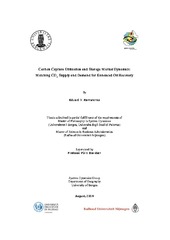Carbon capture utilization and storage market dynamics: Matching CO2 supply and demand for enhanced oil recovery
Master thesis
Permanent lenke
https://hdl.handle.net/1956/8740Utgivelsesdato
2014-08-15Metadata
Vis full innførselSamlinger
- Department of Geography [630]
Sammendrag
This thesis describes the project, which is a part of a wider collaboration between the University of Bergen, Norway and the University of North Dakota (UND) and the Institute for Energy Studies (IES), US established in March 2013. The project was performed by Eduard Romanenko, the author of this thesis, together with his European Master in System Dynamics colleague Julian Andres Gill Garcia, who focused on a different but related aspect of the issue, under the supervision of Prof. Pål Davidsen (University of Bergen) and Scott T. Johnson, a Principal Advisor in the IES. The fieldwork was conducted in March-May 2014 in Grand Forks, ND. There is currently a significant number of carbon capture, utilization, and storage (CCUS) technologies under development and assessment in the US and globally. Most of these technologies have been tested in small scale. The IES has developed and successfully tested the UND technology called CACHYS. Yet, the further commercialization of this and similar technologies is constrained by unfavorable economics of high costs and uncertain potential benefits. On the other hand, there is the CO2-Enhanced Oil Recovery (EOR) industry whose current development is constrained by the lack of CO2 supplies. For the CCUS developers like the IES, CO2-EOR represents an excellent source of demand, which has the potential to pay additional costs of CCUS commercialization. The challenge is that there is a gap between the maximum willingness to pay for CO2 by EOR operators and the costs of CO2 capture by the CCUS. Yet, there is a potential for costs reduction attributed to anticipate learning effect in the CCUS industry. To study the problem, the system dynamics model of an integrated CO2-EOR-CCUS system, similar to the demand-pull market for carbon dioxide currently developing in the Permian Basin, TX, has been constructed. By making explicit the key feedback structure behind the CO2-EOR-CCUS system, the model reveals the reinforcing mechanisms that can potentially generate the self- sustaining growth and provides a simulation environment where policies aimed at activating those mechanisms can be tested on their robustness. The thesis is structured as following. Chapter 1 defines the context, problem, research objectives and research questions. Chapter 2 describes the structure of the model both from stock-and-flow and feedback perspective. Chapter 3 is devoted to the behavior that the model produces. Chapter 4 establishes the confidence in the model through validation analysis. Chapter 5 deals with policy design and testing. The thesis concludes with the summary of results, a discussion on limitations and directions for further work.
